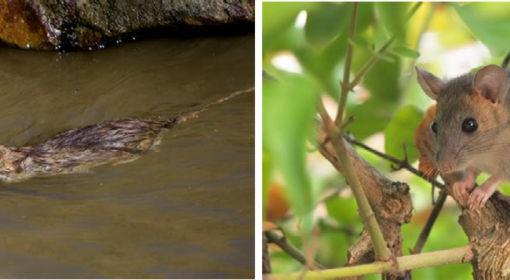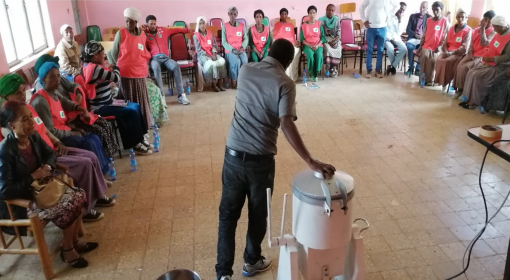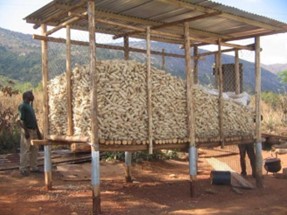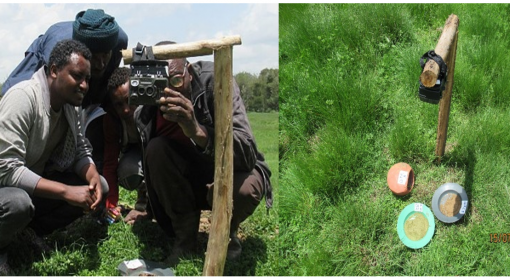by Getachew Engdayehu, Bantamlak Wondmnow, and Luwieke Bosma
Background
Despite severe problems—including substantial crop yield loss, damage to grazing grass, and the transmission of diseases to humans—rodent pests have remained a largely neglected issue in the Amhara region of Ethiopia. Communities have described their struggles with rodent pests and outbreaks in various ways for decades. In recent years, however, one unexpected factor contributing to the problem has been the large-scale watershed rehabilitation programs. While these campaigns have successfully restored landscapes, they have also tended to increase rodent populations. The soil and water conservation structures (such as stone bunds and terraces), the prohibition of free grazing for livestock and introduction of the cut-and-carry system, and changes in cropping calendars are all believed to have provided ample shelter and food for rodents. As a result, rodent populations have increased significantly, serving as a direct warning sign that action is needed.
To deal with the problem there was a need to have alternative biological and ecological methods and to develop a systematic approach on rodent management. This demanded engaging farmers and communities to understand the extent of the problem and combining their indigenous knowledge with scientific research to work towards a sustainable solution, namely Ecologically-based rodent management EBRM).
Lessons Learnt on Ecologically Based Rodent Management in Amhara Region.
Following the successful development and implementation of projects supported by RVO-SBIR and GFF, and carried out through a participatory approach involving farming communities, MetaMeta Research, and the Amhara Bureau of Agriculture, EBRM has marked a paradigm shift. This represents a new approach for large-scale rodent management in the region.
After the concept was tested and replicated—first at the farm level and later through watershed-based experiments over more than three years—villages practicing EBRM have seen a significant decrease in both crop losses and rodent populations. EBRM is now recognized by farmers and practitioners as an effective rodent management approach, although there are still lessons to be learned about combining it with additional strategies. At present, EBRM practices have been implemented and adopted in more than 350 watersheds across large areas of the region. On average, each micro-watershed covers about 500 hectares, meaning the total area under EBRM intervention is nearly 175,000 hectares, involving around 70,000 households (about 350,000 people). The mobilization around EBRM continues to grow, and it has become a routine, regular activity—community-based campaigns for EBRM practices are now common in each watershed.
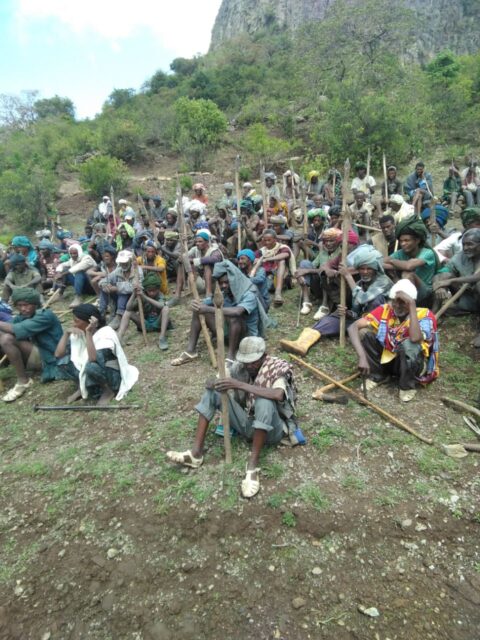
EBRM approach widely adopted and accepted as regular extension system are: (1) Ensuring the cleanliness of grain storage areas and household compounds and preventing rats from entering these areas; (2) controlling the environment in the agricultural fields; including improving cultivation practices such that there are fewer opportunities for rats to thrive, destroying the habitats of rats and ensuring they have no place to hide, improving the quality of soil and water conservation structures; (3) taking specific actions to control and kill rats using biological rodenticides and promoting natural predators (4) controlled grazing rather than zero grazing.
The purpose of this blog, however, is to share the lessons learned and future prospects, specifically in terms of:
- What needs to be considered when integrating EBRM with watershed management campaigns;
- The importance of exploring alternative botanicals, in addition to crinum, for producing bio-rodenticides;
- The need to test and expand the use of cage traps in crop fields for trapping and controlling rodents.
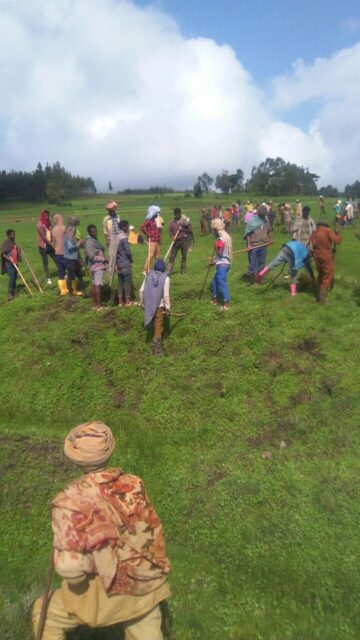
Watershed management campaign approach and EBRM
Aiming to upscale and mainstream EBRM across many community watersheds in the region, the EBRM package has been incorporated into training sessions and standard training materials for Bureau of Agriculture NRM extension services, as well as for woreda and kebele-level experts. The regional NRM strategy, which is centered around community watershed cooperative societies led by committees, presents a valuable opportunity for better environmental control in agricultural fields. This includes improving cultivation practices to reduce opportunities for rats to thrive, destroying rat habitats to deny them hiding places, and enhancing the quality of soil and water conservation structures.
Since the introduction of EBRM in the region, there has been a shift from constructing only stone bunds—which create favorable conditions for rodents to hide and move easily—to adopting soil and stone-faced soil bunds. This approach ensures there are no gaps or spaces between stones, while also making the structures productive by planting on them.
However, several issues need to be considered and incorporated based on past experience. The following are key lessons learned:
- Rodent control campaigns have mainly focused on communal lands, particularly grazing and pasture areas.
- Greater emphasis is needed on a whole-landscape approach, combining all recommended methods (as outlined in the EBRM manual) to effectively control rodent habitats throughout the watershed.
- Community SWC efforts have concentrated on new structures, so more attention should be given to the operation and maintenance of existing structures, especially on small privately owned cultivated lands, during EBRM planning and implementation.
- The role of watershed committees and champion farmers should be strengthened through capacity building and experience-sharing events.
Exploring new botanicals for Bio-rodenticide
As part of the broader EBRM initiative, research was conducted to develop an impactful, easy-to-apply, and user-friendly botanical rodenticide based on farmers’ knowledge and experience. This led to the creation of a bio-rodenticide called ‘’CRIR RODENTICIDE’’ which consists of two botanicals and a bait ingredient. Results showed that the bio-rodenticide reduced rodent-related losses by approximately 50%. These promising outcomes, together with positive farmer feedback, generated considerable interest among farmers and highlighted the importance of integrating this product into the collective EBRM approach.
However, securing a consistent supply of one key raw material, CRINUM, required for producing the bio-rodenticide, remains challenging due to several reasons:
- Its limited geographical distribution in the region.
- It is seasonal and only available through wild harvesting. Attempts to cultivate crinum in nurseries have not been successful so far.
- Because it is only found in certain areas, the logistics and transportation costs for sourcing this material and producing the final product are not financially feasible.
- Getting the product listed as an approved trade item and obtaining licenses for SMEs to produce the bio-rodenticide is very difficult.
As a result, we are now exploring other botanicals to use alongside croton and others. So far, we have identified three potentially suitable alternative plant varieties to crinum. The next step is to explore more types that could be available in different areas, and to conduct testing with knowledgeable farmers. By doing so, we believe that even without a certified bio-rodenticide, farmers in various watersheds can use different botanicals along with other EBRM technologies for more effective and sustainable rodent control.
Testing Cage trap system EBRM
This method of trapping and killing rats could further enhance the impact of other EBRM techniques. Although cluster crop farming systems are being widely promoted in the region—where farming groups come together to carry out most agricultural practices—systematically placing cage trap systems in these clustered farms could be very beneficial. Therefore, we have planned to further assess local knowledge and experience to maximize the effectiveness of this approach.
Scaling Up to More Watersheds
Results from the learning watersheds have been well documented and shared with the Office of Agriculture. Both farmers and extension agents have worked together to develop a system for incorporating EBRM into the regular extension program and scaling it up to more areas where rodent infestation is a problem.
The main mechanisms for spreading the EBRM system include:
- Encouraging the government to take ownership of the initiative;
- Integrating EBRM with watershed mobilization efforts to create synergy;
- Strengthening watershed cooperatives as the main drivers of EBRM;
- Promoting horizontal learning systems;
- Leveraging informal community communication networks, as the EBRM system has already delivered remarkable results and is being adopted by communities through word of mouth.
In conclusion, the progress made so far demonstrates the potential of EBRM as a sustainable and community-driven solution for rodent management at scale. We believe that with continued collaboration and knowledge-sharing, even more communities can benefit from these practices. If you are interested in working with us to expand EBRM to new areas or would like to learn more about our experiences, please feel free to reach out. Together, we can make a significant impact on rodent management and agricultural productivity across the region.
Want to know more? Contact Luwieke via Lbosma@metameta.nl
 |  |  |
 |  |  |
